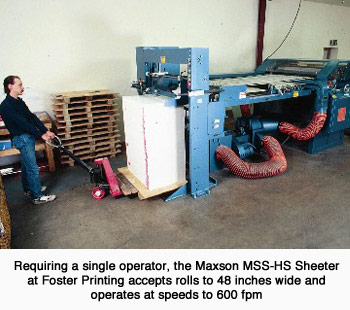In the pressroom of Foster Printing, a sign on the wall reads, “The secret of the greatness is simple: Do better work than anyone else in your field and keep it.” These words embody the spirit of Foster and its president Nick Griswold.
During the last three years, the Michigan City, IN-based firm has seen sales grow by 94 percent, reaching $5 million in 1990. Foster also is a two-time National Assn. Of Printers and Lithographers Management Plus Award winner, receiving a Merit Award in 1989 and gold Award in 1990.
The company’s success depends on a participative management style that encourages employees to achieve. This philosophy, combined with a commitment to service and quality, creates an organization that strives for excellence.
 An emphasis on quality control means products are inspected at each point in the production process before they are released to the customer. “Each department works with and for the next department,” Griswold explains. “For example, we consider the pressroom to be prepress department’s customer.”
An emphasis on quality control means products are inspected at each point in the production process before they are released to the customer. “Each department works with and for the next department,” Griswold explains. “For example, we consider the pressroom to be prepress department’s customer.”
Foster is a full-service printer supplying reprints to the publishing industry. Reprints are reproduced from magazines and are used as sales tools for advertising and sales promotion. Foster’s customers include Delta Communications, Info World and PC World. While the majority of orders are specialty jobs requiring full-color work, Foster’s emphasis is on short-run orders ranging from 500 to 5,000 impressions. The company owns six presses, including four-and five-color Solnas and three one-units.
In August 1990, Foster added to its printing capabilities with the purchase of a five-color Heidelberg Speedmaster. “Our philosophy is to try to improve our equipment,” relates Griswold. We are committed to acquiring technology that will best suit our customers’ needs.”
While the company’s Speedmaster is expected to increase sales by 100 percent, plans acquire a six-color press also are being discussed. This move is expected to further position Foster as a top supplier of reprints to the publishing industry.
The need to operate more efficiently was born of necessity, adds Griswold. “With paper prices and labor costs increasing all the time, expenses increase. Instead of raising prices by five percent, we look for ways of doing business that are different, better and more cost-effective.
“We don’t look straight ahead,” he continues. “Instead we think, ‘what is out there that nobody our size does?’ It might not have anything to do with printing, but how can we apply it our operation?”
This unique approach led Griswold to consider sheeting in-house as a means of reducing paper cost. “Paper purchased in roll form is about 15 percent less expensive than sheets,” Griswold notes. “The savings increase as paper use increases. We knew if we reduced expense we could absorb higher costs without raising prices.”
While the idea of sheeting seemed to make sense on paper, management still wanted to see if it was a viable plan of action. The company purchased a small, used sheeter on the theory that if sheeting did not work out, it would cut its losses.
“As a result of sheeting in-house, we realized substantial savings in paper cost each month,” Griswold says. “Plus, we could get rolls faster than other companies that were waiting for sheets.” The only disadvantage was the limited capability of the older sheeter.

“Once we saw that sheeting was profitable, we wanted something better,” the exec continues. “We knew a new sheeter would allow us to run faster and be more precise.” After researching the types of sheeting equipment available, Foster selected the MSS-HS sheeter from Maxson Automatic Machinery Co. (Westerly, RI). “Besides fitting our need for greater production, the Maxson also gave us the level of accuracy we needed.”
Requiring a single operator, the sheeter reportedly handles rolls to 48 inches wide and operates at speeds to 600 fpm. On a common size such as 23×35 inches, the unit cuts as many as 183,000 sheets during an eight-hour shift.
Equipped with a close tolerance drive, the MSS-HS provides press-ready sheets and is said to eliminate the need to guillotine trim. The new sheeter is housed in the same room as Foster’s Heidelberg press to provide easy transfer of stock to the press.
A sheet length monitor enables operators to preset the desire cutoff without having to web any material into the cutter. This feature helps keep the printer’s waste percentage to within one percent to 1.5 percent.
Foster sheets a single roll of coated paper in 70- to 100-lb. basis weights. Since the stock’s clay coating is prone to chipping, a PEN MAM dust collector was added to the MSS-HS. This device reportedly prevents defects such as hickeys. “We had problems with dust on our first sheeter,” Griswold comments, “but with the Maxson, we’ve had no complaints.”
While sheeting in-house has offered Foster Printing greater flexibility, it also has complemented the company’s growth pattern. Griswold calculates a payback on this investment within two years.
“We bought a sheeter to help us continue to be No. 1,” Griswold says. “We want to be there first, and Maxson is helping us get there.”
Reprinted from American Printer, October 1991






